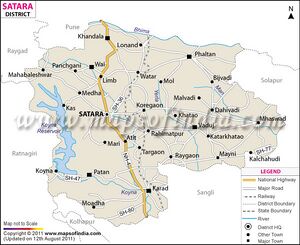Karahataka
| Author:Laxman Burdak, IFS (Retd.) |

Karahataka (करहाटक) was an ancient country mentioned in Mahabharata. It is identified with present city Karad in Satara district of Maharashtra. Sahadeva Pandava had conquered the country of Karahatakas.
Variants
- Karahataka (करहाटक) (AS, p.140)
- Karhatak meaning "Elephant Market"
- Karhada (करहाड़)/Karhad (करहाड़) = Karahataka (करहाटक) (AS, p.141)
- Karhad (करहाड़) = Karad (कराड़)
Location
Karad city in Satara district is located in the southern part of Maharashtra and it is 290 km (180.19 miles) from Mumbai and 159 Km from Pune. It lies at the confluence of Koyna River and the Krishna River. The two rivers originate at Mahabaleshwar, which is around 100 km from Karad. They diverge at their origin, and travel for about the same distance to meet again in Karad. Karad is well known for sugar production and is known as the sugar bowl of Maharashtra owing to the presence of many sugar factories in and around Karad.
History
Karad was originally known as "Karhatak", meaning "Elephant Market". Karad is also a city of historical importance. According to Mahabharata, Sahadeva one of the Pandavas lived in the city also known to be pious as Lord Rama stepped his feet on this land[1]. Located to the south west of Karad is Karad Caves.[2]
The first capital of the Shilaharas was probably at Karad during the reign of Jatiga-II as known from their copper plate grant of Miraj and Vikramankadevacharita of Bilhana. Hence sometimes they are referred as 'Shilaharas of Karad'. The capital was later shifted to Kolhapur. Among the Silaharas of Kolhapur who ruled over Satara and Belganv districts from 1000 to 1215 A. D., Gonka deserves mention here, as he is described as the Lord of Karhad (Karad), Mairifvja (Miraj) and Konkan.[3]
Also a Major event in history is witnessed by the Krishna River Banks, His Highness Chhatrapati Shivaji Maharaj once washed his weapon which is known as Waghnakhya and Bichhwa in the River Krishna's waters
Karad is considered as an important educational hub in Western Maharashtra due to the presence of many prestigious educational institutes. This place is also known for resting place or (Samadhi) of the first chief minister of Maharashtra Shri. Yashwantrao Chavan situated at the confluence of Krishna and Koyana river.
Jat cland
- Karad (कराड़)
करहाटक
विजयेन्द्र कुमार माथुर[4] ने लेख किया है ...करहाटक (AS, p.140) बंगलोर-पुणे रेल मार्ग पर पुणे से 124 मील दूर करहाड़ ही प्राचीन करहाटक है। करहाटक में कृष्णा और ककुद्मती नदियों का संगम होता है। करहाड़ से 10 मील पर कोल नृसिंह ग्राम में महर्षि पराशर द्वारा स्थापित नृसिंह-मूर्ति है। महाभारत सभा पर्व (सभा पर्व महाभारत 31, 70) में करहाटक पर सहदेव की विजय का उल्लेख है-'नगरी सज्यंती च पाखंडं करहाटकं दूतैरेवशे चके करं चैनानदापयत्'।
कुकुद्मती = कोयना
विजयेन्द्र कुमार माथुर[5] ने लेख किया है ...कुकुद्मती = कोयना (AS, p.124) : इस नदी का उद्गम महाबलेश्वर की पहाड़ियों में है. पुराणों के अनुसार कुकुद्मती ब्रह्मा के अंश से संभूत है. कुकुद्मती- क़ृष्णा संगम पर करहाड़ या प्राचीन करहाटक बसा हुआ है.
In Mahabharata
Karahataka (करहाटक) is mentioned in (II.28.47).
Sabha Parva, Mahabharata/Book II Chapter 28 mentions Sahadeva's march towards south: kings and tribes defeated. Karahataka (करहाटक) is mentioned in verse (II.28.47).[6]....Having brought under subjection king Timingila, conquered a wild tribe known by the name of the Kerakas who were men with one leg. The son of Pandu (Sahadeva) also conquered the town of Sanjayanti and the country of the Pashandas and the Karahatakas by means of his messengers alone, and made all of them pay tributes to him.
Notable persons
References
- ↑ http://www.mygola.com/karad-d1011495/hindu-temple
- ↑ Ahir, D. C. (2003). Buddhist sites and shrines in India : history, art, and architecture (1. ed.). Delhi: Sri Satguru Publ. p. 197. ISBN 8170307740.
- ↑ [Journal of the Royal Asiatic Society, Vol. IV, p. 281, Sanskrit Transcript.]
- ↑ Aitihasik Sthanavali by Vijayendra Kumar Mathur, p.140
- ↑ Aitihasik Sthanavali by Vijayendra Kumar Mathur, p.124
- ↑ एकपादांश च पुरुषान केवलान वनवासिनः, नगरीं संजयन्तीं च पिच्छण्डं करहाटकम, दूतैर एव वशे चक्रे करं चैनान अथापयत (II.28.47)

